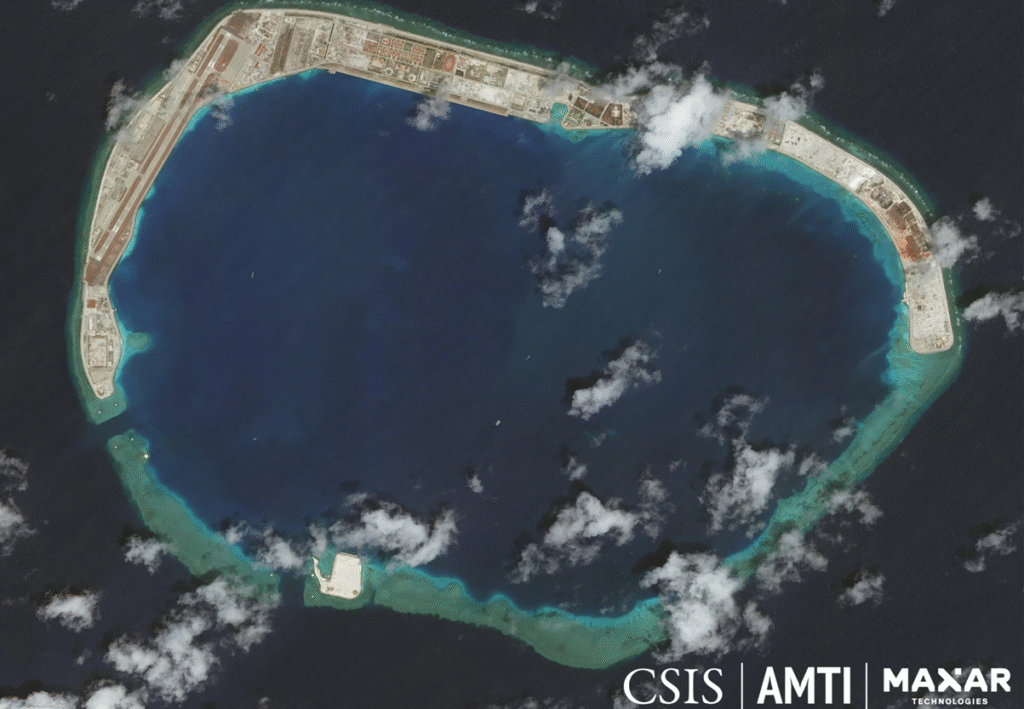A Newsweek timelapse compiled from a decade of satellite imagery shows how China transformed an artificial island in the South China Sea into a large military outpost comparable to an unsinkable aircraft carrier.
Mischief Reef had been a low-tide atoll in the contested Spratly Islands before China began reclaiming land around its rim in the 1990s, work that was largely completed by 2015. Beijing then spent the next 10 years turning the man-made feature into its largest military base in the area.
Why It Matters
China claims sovereignty over more than 80 percent of the South China Sea, an energy-rich waterway through which as much as $5 trillion in trade flows each year.
Those claims extend to the Spratly Islands, where Chinese dredgers have created more than 3,000 acres of new land across seven reefs. The archipelago is also claimed—fully or in part—by Vietnam, the Philippines, Malaysia, Taiwan and Brunei.
China has equipped Mischief Reef and at least two other features, known as Subi and Fiery Cross reefs—with military infrastructure, from airstrips to missile launchers, enhancing the People’s Liberation Army’s ability to project power in the region and increasing tensions with the Philippines, a U.S. defense treaty ally.
Newsweek reached out to the Chinese Foreign ministry and Philippine armed forces via emailed request for comment.
What To Know
Mischief Reef lies roughly 150 miles west of Palawan, a major Philippine island province and approximately 600 miles from China’s southernmost island of Hainan. It is within the exclusive economic zone of the Philippines—where the Southeast Asian country alone is entitled to natural resources under international maritime law.
China began occupying Mischief Reef in 1994, initially claiming the area was used to support Chinese fishermen.
A time lapse of images taken by the European Space Agency Sentinel-2 satellites shows the enormous scope of China’s military build up there.
Despite Chinese President Xi Jinping’s pledge to then-U.S. President Barack Obama not to militarize its outposts, analysts have identified military infrastructure such as a 10,000-foot runway, helipads, fighter jet hangers, anti-ship cruise missile systems, and sophisticated radar placements on the reef.
Known in Beijing as Meiji Reef and in Manila as Panganiban Reef, the artificial island provides key support to Chinese forces as they expand patrols in the Philippines’ maritime zone.
The Philippines under President Ferdinand Marcos Jr. has responded by stepping up its pushback against China’s presence in the zone and strengthened defense coordination with the United States and other partners in the region.
Meanwhile, Vietnam has since 2023 accelerated its own land reclamation in the Spratlys—now totaling over two-thirds the acreage of China’s.
What People Have Said
Gilberto Teodoro, Philippine defense chief, spoke of a “trust deficit” with China during the Shangri-La Dialogue summit in Singapore in June: “I just look back to 1995 in a place called Mischief Reef. There were a few bamboo structures erected there. And China said that these were “temporary havens for fisher folk. Now you have artificial military islands—heavily militarized.”
Gregory Poling, director of Washington, D.C., think tank CSIS’ Southeast Asia Program, told the Australia Broadcasting Corporation: “China can [through its radar systems on artificial islands] see and hear and communicate across the whole South China Sea in a way that nobody else, including the United States, can.”
Chinese Foreign Ministry spokesperson Guo Jiakun said of Vietnam’s land reclamation operations during a press briefing Monday: “The Nansha [Spratly] Islands are China’s inherent territory, and China firmly opposes the construction activities of the countries concerned on the illegally occupied islands and reefs and will take necessary measures to safeguard its territorial sovereignty and maritime rights.”
What’s Next
Mischief Reef is expected to remain a key hub for China’s maritime operations in the South China Sea.
Vietnam’s addition of airstrips, harbors and suspected weapons sites in the Spratlys signals a long-term bid to strengthen its position, though clashes between China and the Philippines near hot spots in the Philippine EEZ are the main driver of tensions in the archipelago.
Read the full article here

